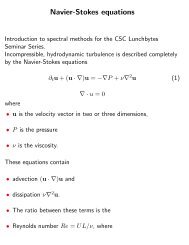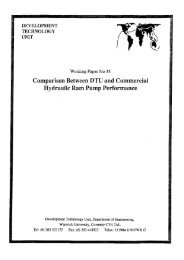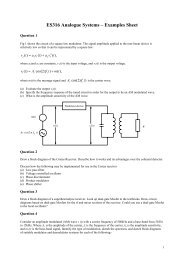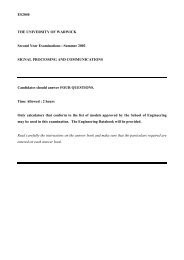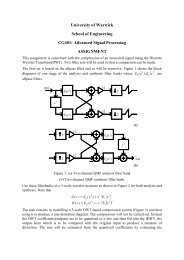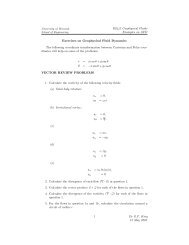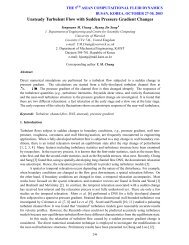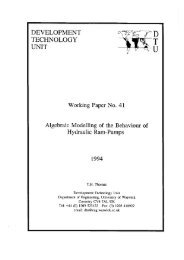Abstracts - KTH Mechanics
Abstracts - KTH Mechanics
Abstracts - KTH Mechanics
Create successful ePaper yourself
Turn your PDF publications into a flip-book with our unique Google optimized e-Paper software.
24<br />
Beta-plane turbulence in a basin with no-slip boundaries<br />
W. Kramer ∗ , H.J.H. Clercx ∗ and G.J.F. van Heijst ∗<br />
On a domain enclosed by no-slip boundaries, two-dimensional, geostrophic flows<br />
have been studied by numerical simulations of the Navier-Stokes equation with the<br />
beta-plane approximation at intermediate Reynolds numbers and a range of values<br />
for beta 1 . While most of the results are in agreement with other studies which use<br />
different boundary conditions, some aspects show a different and unexpected behavior.<br />
Without the beta-plane the flow is characterized by the formation of a single domainsized<br />
coherent vortex due to the inverse energy cascade. From the simulations with<br />
the presence of the beta-effect it can be observed that the inverse cascade is clearly<br />
impeded by the presence of a beta-plane. This leads to a refinement of the flow<br />
structures (Figure 1a), which scales are in agreement with the Rhines scale. When<br />
the growing flow scales reach sizes comparable with the Rhines scale, the beta-effect<br />
becomes dynamically more important than advection and, consequently, the Rossby<br />
wave mechanism takes over from the inverse cascade. The arrest of the inverse cascade<br />
is visible as a plateau for wave numbers smaller than the Rhines wave number (Figure<br />
1b). On a closed domain Rossby waves are described by basin modes, which are<br />
solutions of the inviscid flow equation on a bounded domain with free-slip boundaries.<br />
Frequency spectra of the flow profoundly exhibit the existence of basin modes, which<br />
excitation is favoured above the formation of vortices. The presence and apparent<br />
stability of basin modes on a domain with no-slip boundaries is a rather surprising<br />
observation, because these modes are solutions of the inviscid equations. The timemean<br />
flow in forced simulations shows a zonal band structure (Figure 1c) which<br />
resembles the flow on a periodic domain (although the kinetic energy of the mean<br />
flow represents only 2-4% of the kinetic energy of the turbulent flow field itself). This<br />
a rather surprising result as numerous other simulations show a mean flow consisting<br />
of a dual gyre on a closed domain. The difference can be subscribed solely to the<br />
applied no-slip boundary conditions.<br />
∗ Fluid Dynamics Laboratory, Eindhoven University of Technology, The Netherlands.<br />
1 W. Kramer et al., Phys. Fluids, accepted for publication.<br />
<br />
a<br />
b<br />
<br />
c<br />
k -5/3 k -3<br />
<br />
<br />
<br />
E(k)<br />
<br />
<br />
<br />
<br />
<br />
kRhines<br />
kf<br />
k<br />
<br />
Figure 1: The stream function for the time dependent flow field (a) the 1D Chebyshev<br />
spectrum of the kinetic energy (b) and the time averaged stream function (c) .



